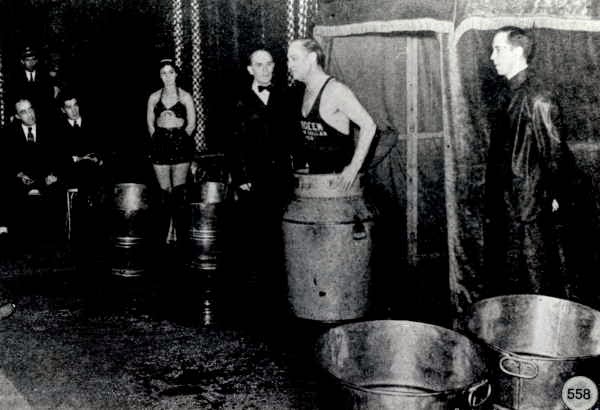There's a detailed description of Houdini's Water Torture Cell performance at the New Cross Empire in London on May 14, 1913. This can be read in The Original Houdini Scrapbook by Walter B. Gibson (page 108). It describes all the apparatus Houdini used, right down to the "ornamental cauldrons" filled with heated water. It doesn't mention a giant clock.
In fact, I'm not sure there is any mention of a clock in any description of Houdini's act from the time (although I admit I've not mounted a very aggressive search). Also, if this major prop existed, what happened to it? A fair amount of Houdini's apparatuses survives and have traded hands over the years. But no clock. And if there was a giant clock, why is it not present in Houdini stage photos such as THIS? We also have a nice photo of Hardeen performing the Milk Can late in his career on a decidedly clockless stage.
Again, I haven't dug too deeply into this, but I expect this giant clock idea originated in the Tony Curtis Houdini movie of 1953. In that film we see a giant clock on stage counting down Harry's last moments as he fails to free himself from his "Pagoda Torture Cell." It certainly wouldn't be the only enduring myth generated by that film.
So have we all been lulled into believing the myth of the giant clock? Is it time to retire this timepiece? Clock in with your thoughts below.
UPDATE: Forget everything I wrote above. Our friend Joe Notaro has found solid evidence that this giant clock/stop-watch existed, or at least Houdini conceived of it. In his book Houdini's Magicial Rope Ties and Escapes (1920), Houdini writes:
"My assistant is always supplied with a stop-watch; in fact for my under-water tests, I had specially made by a watchmaker in Glasgow, the largest stop-watch in the world, by means of which persons in the gallery who did not possess such watches themselves could see the second hand as it jumped around the dial, and thus share in the interest, for you should know that not every theatre-goer carried a stop-watch."
So if there was indeed a giant clock, as appears to be the case, the question remains; what happened to it?
UPDATE 2: And now here's evidence of the clock in action, here referred to as "a huge chronometer."
 |
| The Guardian, July 20, 1909. |





The gimmick of a clock on stage was something I just expected Houdini to use, as yet another way to rachet up the suspense, even before I saw the Tony Curtis film; but now that you mention it, I've never seen any photographs or newspaper reports to even mention a clock. I guess he relied on people in the audience checking their watches. I'm inclined to believe it was a Hollywood invention, as Houdini did seem to prefer performing with a relatively bare stage.
ReplyDelete-Meredith
I stand corrected. After a little digging, I found this article from the Washington Times from September 29, 1906, mentioning quite plainly in black and-white a "stage clock." http://chroniclingamerica.loc.gov/lccn/sn84026749/1906-09-29/ed-1/seq-5/
ReplyDeleteI guess this isn't one of Hollywood's inventions after all.
-Meredith
I now agree with Joe below. The article says, "the stage clock pointed to midnight." That isn't a giant stopwatch; that's just a normal clock. In Rope Ties, HH says he had it made in Glasgow specifically for the Milk Can escape. That could only be 1909. And the first reference I can find to a "huge chronometer" is indeed in 1909 (posted in update).
DeleteNice article on HH escaping from a piano box! However, I don’t believe the “stage clock” in the article is the giant stop watch (Houdini prop) that some of the well-known biographers refer to, but is just a regular clock hanging from the stage that showed midnight when he escaped. I believe the reference for the stop-watch is from Houdini’s Magical Rope Ties & Escapes:
ReplyDelete“My assistant is always supplied with a stop-watch; in fact for my under-water tests, I had specially made by a watchmaker in Glasgow, the largest stop-watch in the world, by means of which persons in the gallery who did not possess such watches themselves could see the second hand as it jumped around the dial, and thus share in the interest, for you should know that not every theatre-goer carried a stop-watch”.
So the giant stop watch came from Houdini Himself.
Oh, dang! You know, that quote now sounds familiar to me. So the clock/stopwatch did indeed exist. Now to just see it.
DeleteLooks like Meredith solved the mystery! You know, I don't even remember the clock in the Houdini/Tony Curtis movie, lol. It's clearly there in the photo though.
ReplyDeleteIn all truth though, we still don't know if the clock was used for the USD or Milk Can. But at least we know he had one at one time.
Never mind the clock problem, who's the cute brunette standing in the back near the curtain watching Hardeen?
ReplyDeleteWe see Collins in this photo and 4 large buckets used to fill the Milk Can. There is a similar photo of an old Hardeen on page 60 of the J.C. Cannell book. He's wearing the same black swimming trunks that says "Million Dollar Pier" on the chest and has 3 committee members seated near the main event. Although, I don't believe the 2 photos represent the same performance.
No more mystery here. I know when and where Houdini had it made and when he started using it. Will be in my book.
ReplyDelete